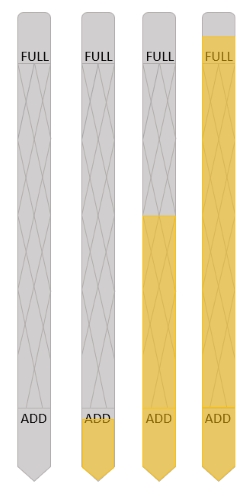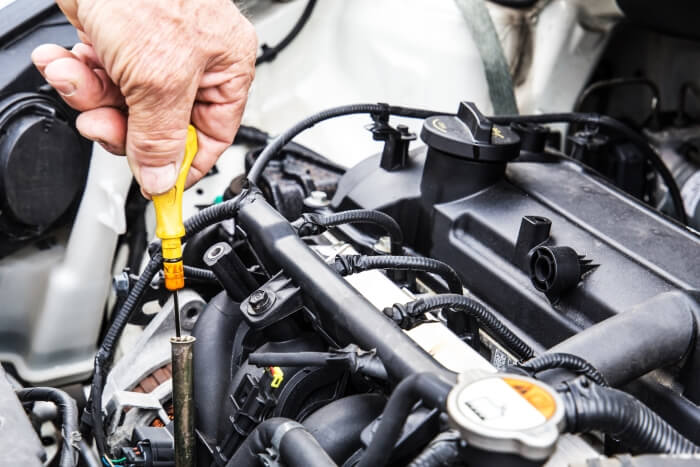


What is oil dilution?
Oil dilution is the term used to describe the increase in the oil level in the engine. This happens by the entry of fuel into the engine oil. The causes of oil dilution can be various and also depend on the fuel required (diesel or petrol).
Petrol in oil - motor oil smells like petrol
If your oil level is too high and you also notice a smell of petrol in the engine oil, there is a good chance that your gasoline engine has an oil dilution. Petrol settles on the cylinder walls during cold starts and is introduced into the oil via the piston ring. This results in a mixing of oil and fuel. Since the oil in the engine does not heat up strongly enough, the fuel is not completely burned. Parts of the fuel remain in the lubricant and continue to dilute it. The oil level can therefore rise slowly.
Diesel in oil
Oil dilution also occurs in diesel vehicles. The reason for this is the post-injection of diesel to clean the diesel particle filters. During post-injection, additional diesel is injected into the cylinder chamber. This fuel is supposed to reach the diesel particulate filter with the exhaust gases and to clean the filter there. However, not all parts of the post-injection are always actually emitted. Smallest amounts of diesel stick to the cylinder walls and enter the engine compartment through the piston movement. As a result, diesel enters the engine oil and increases the oil level.
Likewise, the diesel entry in the engine can increase when often driving short distances. Diesel only evaporates at approx. 55 °C. If this temperature is not reached in the engine compartment, parts of the diesel accumulate in the oil.
The problem of oil dilution becomes even more critical when using biofuels. These have a much higher flash point and do not evaporate at all during normal engine operation.
| Fuel | Flash point | Ignition temperature |
| Petrol | approx. -20 °C | approx. 200 °C |
| Diesel | approx. 55 °C | 220 °C |
| Biodiesel | 180 °C | approx. 250 °C |
| Rapeseed oil | 317 °C | approx. 300 °C |
Is my vehicle affected by the problem oil dilution?
The first indication of oil dilution is to measure the oil level. Here you can find instructions on how to do this. If the measurement level of the engine oil is too high, there may be a dilution of the oil. In this case, it is recommended to take an oil sample from the vehicle in order to determine in the laboratory whether there is an increased amount of fuel in the oil.

Is oil dilution dangerous?
At what point the oil dilution becomes dangerous for the engine can only be precisely determined by the engine manufacturer. Only there the appropriate tests are made. Unfortunately, this information is rarely published. Some laboratories classify the limit value of fuel in the oil at 2-4%, others around 5% as critical. This value also differs between petrol and diesel vehicles.
| Fuel entry in oil | Normal | Increased | Critical |
| Petrol | < 1% | 1 - 2,5% | > 2,5% |
| Diesel | < 3% | 3 – 5% | > 5% |
Source: OelCheck – Handbuch Ölanalysen (2020)
It is certain that any amount of fuel in the oil changes the viscosity. Too much fuel in the oil leads to a lack of lubrication. The optimum oil pressure can no longer be built up. From a purely technical point of view, the engine oil would have to be changed at the latest when it is no longer within the SAE class limit.
As examples we have added limit values of the common SAE classes 30 and 40.
| SAE | 30 | 40 |
| Viscosity at 100 °C | 9.3 - 12.5 mm²/s | 12.5 - 16.3 mm²/s |
| Recommended change | ≤ 9 mm²/s | ≤ 12 mm²/s |
In addition, oil dilution not only reduces the viscosity of the engine oil, but also its quality. With all the impurities, an increased ageing behaviour of the oil comes into play. The processes acting here can, among other things, form acids and trigger corrosion. This can cause long-term engine damage.
As fuel enters the oil, the falling flash point is a factor, too. If an engine oil in its fresh state has a flash point of approx. 240 °C, this may be less than 100 °C when highly diluted. This increases the risk of fire in the engine compartment.
A high proportion of biofuel in the oil can lead to an increase in the viscosity of the engine oil over a longer period of time until its complete polymerisation.
How can oil dilution be avoided?
The effect of oil dilution is intensified by driving short distances, especially in cold outside temperatures. The engine is often started cold and rarely reaches the optimum operating temperature. This causes a lot of fuel to accumulate in the oil. If you have to drive many short distances, it is always advisable to move the vehicle over longer distances and drive at higher speeds.
Another reason for oil dilution can be a defective thermostat in the radiator. If the radiator cools the engine down too much, too much fuel is deposited on the cylinder walls. Have the functionality of the thermostat checked in case of doubt.
If none of the measures should lead to success, the last step is a more frequent oil change to replace the contaminated oil. Especially for engines with longlife fillings, shortening the change interval to, for example, one year (instead of two years) can be helpful.

